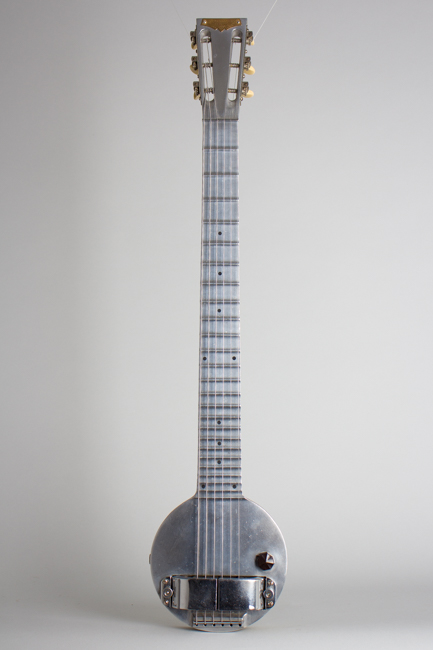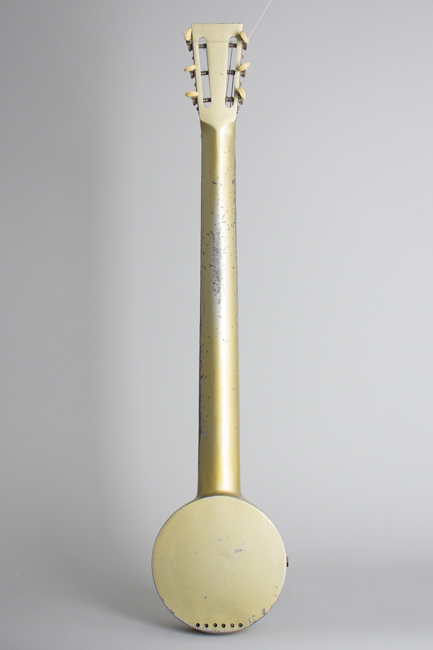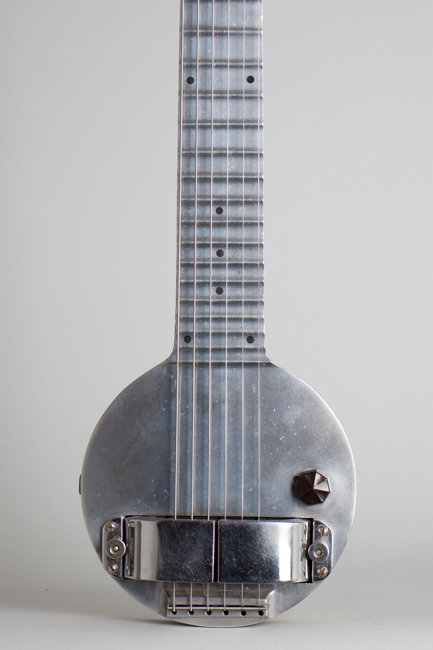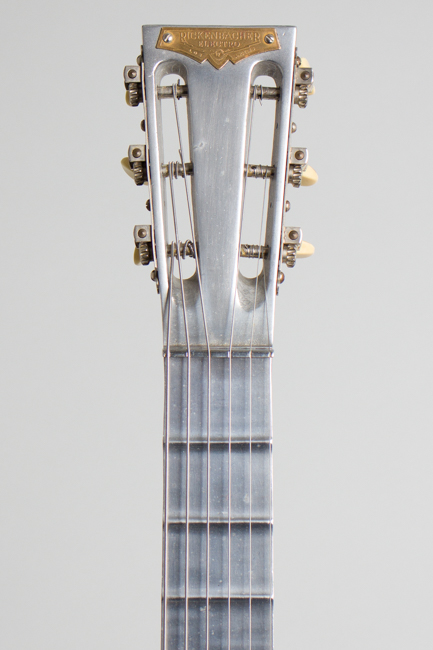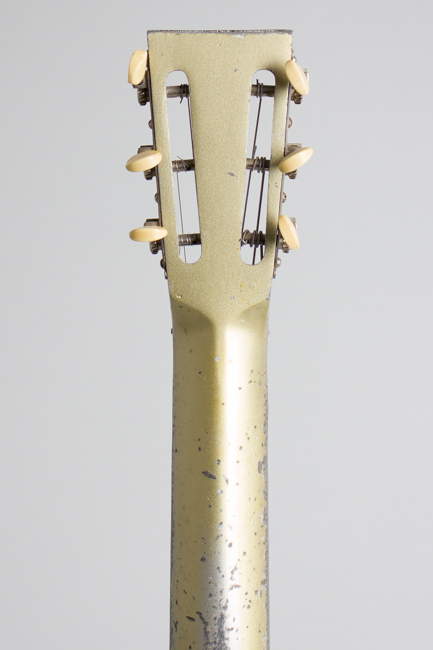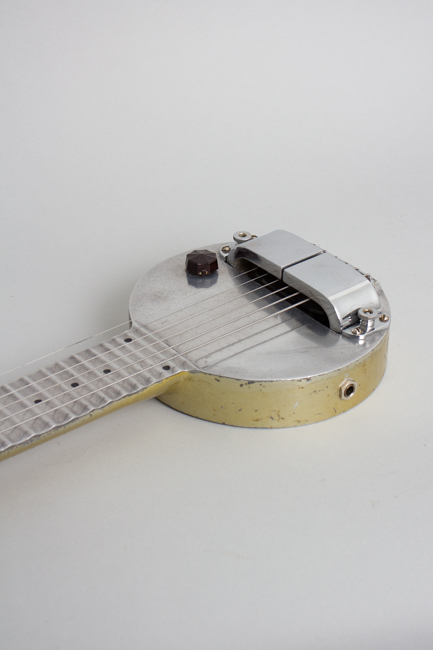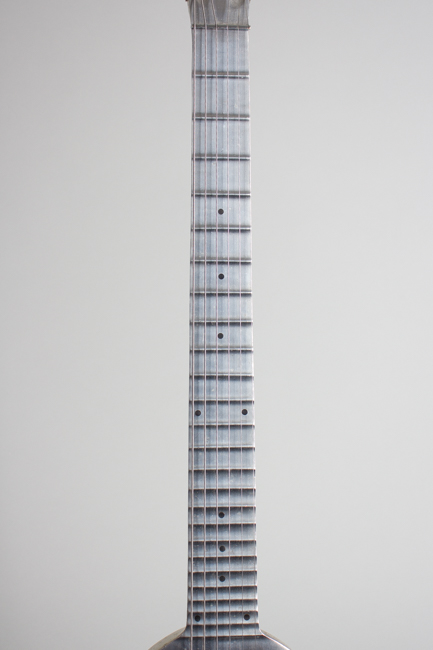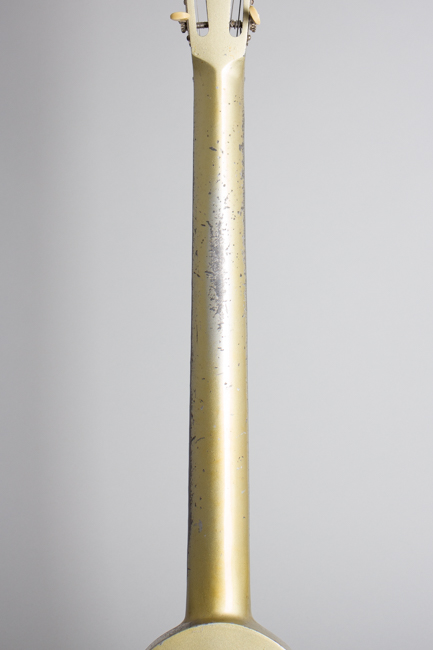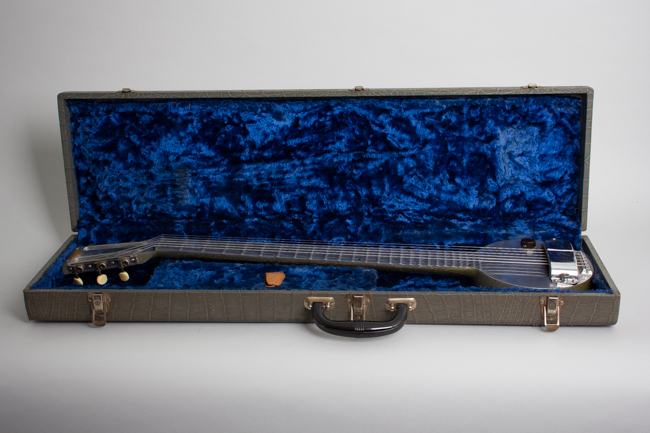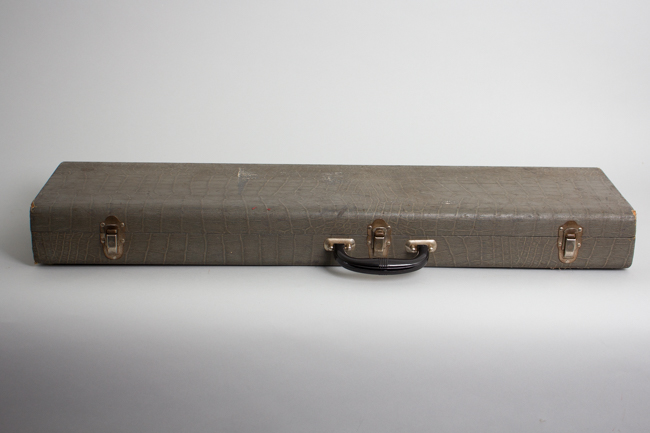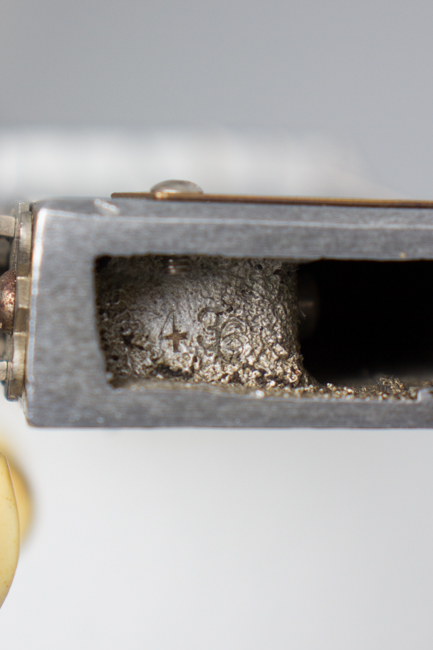Rickenbacker A-25 Lap Steel Electric Guitar (1934)
This item has been sold.
Item # 11281
Prices subject to change without notice.
Rickenbacker A-25 Model Lap Steel Electric Guitar (1934), made in Los Angeles, gold enamel finish, cast aluminum body and neck, grey alligator hard shell case.
This extremely rare Rickenbacher A-25 Electro Hawaiian Guitar (nicknamed the "Frying Pan" for its distinctive shape) is simply one of the most historically important of all 20th Century guitars. This was the first commercially successful electrified string instrument as well as the first (more or less) solid body guitar. It was the initial carrier of the celebrated pre-war 1 1/2 inch horse shoe magnet pickup, the first electro-magnetic instrument pickup to be perfected and still one of the greatest-sounding units ever. While Rickenbacker went on to produce many other instrument designs, the "Frying Pan" is where it all began for both this California company and electric guitars in general.
The instrument was first offered in *extremely* small numbers in 1932-3 as the Model A-25, with a 25" scale length. A companion A-22 model with a 22" scale followed and as the short scale became more accepted on Electric Hawaiian guitars the A-25 was heavily outsold by it. The number of extant A-25s is very small; many are rumored to have been collected for scrap aluminum drives during WWII! They rarely come up for sale 80+ years later in the 21St Century. The A-25 was marketed as a Hawaiian guitar, but the neck is round-backed so theoretically the instrument could have been played Spanish style, something designer George Beauchamp alluded to in the original patent application.
The very first Electro steels from 1932-3 have no onboard controls, this example has a single volume pot with an octagonal knob on the top. The fingerboard is integral with the neck and has raised ridges for frets and black position dot markers. The entire instrument extremely futuristic for the 1930's, a high deco minimalist design fabricated from a single piece of cast aluminum with a hollow space inside. This body was finished in a fairly fragile gold enamel wash that is partially intact on this example. The strings run through the body and over a separate chromed metal saddle, through the horseshoe magnet pickup and on over a chromed brass nut to the slotted headstock.
The pickup is the first major version of the famous Rickenbacker horseshoe unit with the old thick 3/8" magnets and long individual poles in the coil. The unit is adjustable overall for height with a knurled knob at each end; these first pattern mounting flanges have no "Pat. Applied For" stamp. The slotted headstock has a brass metal name plate that reads "Richenbacher Electro, Los Angeles" with "RE" between mirrored lightning bolts. The combination of the serial number without an "A" prefix and these features suggest this example dates to no later than 1934; early Rickenbackers show somewhat inconsistent features and markings as the tiny Los Angeles factory could be pretty lackadaisical about fine details.
This example has some wear overall but still sounds fantastic. Amazingly enough even nearly 90 years on the guitar itself is still a very fine musical instrument and remains one of the best-sounding steel guitars ever produced. While there will always be some debate as to who made the "Absolute First" electric guitar, the introduction of the Rickenbacker Electro established a market for the amplified instruments, and the company dominated it in these first years. Inventor George Beauchamp's electro-magnetic stringed instrument pickup was by far the best sounding and most successful of the early designs and set the basic pattern form all that have come since. The A-25 remains unique, in some ways as modern as when it was first introduced and certainly one of the most distinctive guitars ever designed.
Overall length is 31 1/4 in. (79.4 cm.), 6 3/4 in. (17.1 cm.) across at the widest point, and 1 1/2 in. (3.8 cm.) in depth, measured at side of rim. Scale length is 25 in. (635 mm.). Width of nut is 1 7/8 in. (48 mm.).
This rare A-25 shows some wear overall but remains a fine playing and amazing sounding example of this historically important and highly sought-after lap steel guitar. The heart of the instrument -- the original pickup -- is completely intact and sounds fantastic, with tons of volume and a truly singing sound. The single volume control still has the original fragile octagonal knob fitted.
The gold-wash enamel finish on these very early Rickenbackers is inconsistent and often proved fragile in use. This one has a natural polished aluminum top face and the gold enamel on the back and sides; We would assume the top has had the enamel polished off eons ago although we have seen enough of these in this state it is hard to be absolutely certain. At any rate the remaining enamel on the back and sides has numerous chips, scrapes, dents and dings but no larger areas worn away.
The thick pickup magnets have quite thick plating and are very clean on the top; many later ones have been corroded badly by now. The flat-plate tuners are original; The top tuner on the treble side is badly bent but functional. This is a wonderful playing and sounding example of this sublime instrument; this still hardy survivor of the first electric age represents one of the true holy grails for steel guitar players and electric instrument collectors worldwide. The slim rectangular hard case included is period Rickenbacker styled but later than the guitar, likely 1940s issue. It is quite well preserved and works fine. Overall Excellent - Condition.
This extremely rare Rickenbacher A-25 Electro Hawaiian Guitar (nicknamed the "Frying Pan" for its distinctive shape) is simply one of the most historically important of all 20th Century guitars. This was the first commercially successful electrified string instrument as well as the first (more or less) solid body guitar. It was the initial carrier of the celebrated pre-war 1 1/2 inch horse shoe magnet pickup, the first electro-magnetic instrument pickup to be perfected and still one of the greatest-sounding units ever. While Rickenbacker went on to produce many other instrument designs, the "Frying Pan" is where it all began for both this California company and electric guitars in general.
The instrument was first offered in *extremely* small numbers in 1932-3 as the Model A-25, with a 25" scale length. A companion A-22 model with a 22" scale followed and as the short scale became more accepted on Electric Hawaiian guitars the A-25 was heavily outsold by it. The number of extant A-25s is very small; many are rumored to have been collected for scrap aluminum drives during WWII! They rarely come up for sale 80+ years later in the 21St Century. The A-25 was marketed as a Hawaiian guitar, but the neck is round-backed so theoretically the instrument could have been played Spanish style, something designer George Beauchamp alluded to in the original patent application.
The very first Electro steels from 1932-3 have no onboard controls, this example has a single volume pot with an octagonal knob on the top. The fingerboard is integral with the neck and has raised ridges for frets and black position dot markers. The entire instrument extremely futuristic for the 1930's, a high deco minimalist design fabricated from a single piece of cast aluminum with a hollow space inside. This body was finished in a fairly fragile gold enamel wash that is partially intact on this example. The strings run through the body and over a separate chromed metal saddle, through the horseshoe magnet pickup and on over a chromed brass nut to the slotted headstock.
The pickup is the first major version of the famous Rickenbacker horseshoe unit with the old thick 3/8" magnets and long individual poles in the coil. The unit is adjustable overall for height with a knurled knob at each end; these first pattern mounting flanges have no "Pat. Applied For" stamp. The slotted headstock has a brass metal name plate that reads "Richenbacher Electro, Los Angeles" with "RE" between mirrored lightning bolts. The combination of the serial number without an "A" prefix and these features suggest this example dates to no later than 1934; early Rickenbackers show somewhat inconsistent features and markings as the tiny Los Angeles factory could be pretty lackadaisical about fine details.
This example has some wear overall but still sounds fantastic. Amazingly enough even nearly 90 years on the guitar itself is still a very fine musical instrument and remains one of the best-sounding steel guitars ever produced. While there will always be some debate as to who made the "Absolute First" electric guitar, the introduction of the Rickenbacker Electro established a market for the amplified instruments, and the company dominated it in these first years. Inventor George Beauchamp's electro-magnetic stringed instrument pickup was by far the best sounding and most successful of the early designs and set the basic pattern form all that have come since. The A-25 remains unique, in some ways as modern as when it was first introduced and certainly one of the most distinctive guitars ever designed.
Overall length is 31 1/4 in. (79.4 cm.), 6 3/4 in. (17.1 cm.) across at the widest point, and 1 1/2 in. (3.8 cm.) in depth, measured at side of rim. Scale length is 25 in. (635 mm.). Width of nut is 1 7/8 in. (48 mm.).
This rare A-25 shows some wear overall but remains a fine playing and amazing sounding example of this historically important and highly sought-after lap steel guitar. The heart of the instrument -- the original pickup -- is completely intact and sounds fantastic, with tons of volume and a truly singing sound. The single volume control still has the original fragile octagonal knob fitted.
The gold-wash enamel finish on these very early Rickenbackers is inconsistent and often proved fragile in use. This one has a natural polished aluminum top face and the gold enamel on the back and sides; We would assume the top has had the enamel polished off eons ago although we have seen enough of these in this state it is hard to be absolutely certain. At any rate the remaining enamel on the back and sides has numerous chips, scrapes, dents and dings but no larger areas worn away.
The thick pickup magnets have quite thick plating and are very clean on the top; many later ones have been corroded badly by now. The flat-plate tuners are original; The top tuner on the treble side is badly bent but functional. This is a wonderful playing and sounding example of this sublime instrument; this still hardy survivor of the first electric age represents one of the true holy grails for steel guitar players and electric instrument collectors worldwide. The slim rectangular hard case included is period Rickenbacker styled but later than the guitar, likely 1940s issue. It is quite well preserved and works fine. Overall Excellent - Condition.
